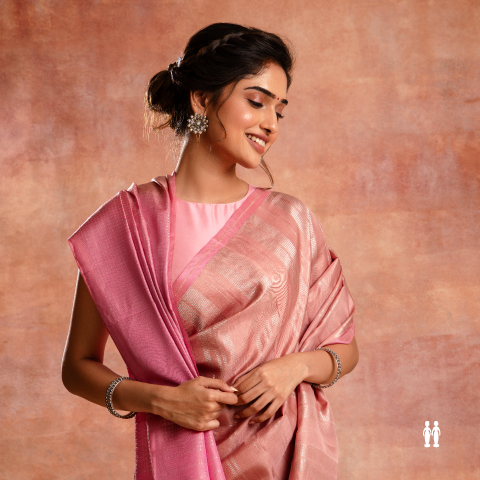An ethnic weave that is characterised for its lustrous appearance and featherlight texture is the Chanderi saree. The craft was initially practised by the Muslim weaving community and later became native to Chanderi in Madhya Pradesh when the Koshti weavers from Jhansi migrated and settled in this quaint town during 1350. An eminent weaving culture was established during the 2nd and 7th centuries between the regions of Malwa and Bundelkhand.
The fabric was also believed to be introduced by Lord Krishna’s cousin Shishupal during the Vedic period. A favourite amongst the queens and princesses of ancient kingdoms, this fabric was considered to be a symbol of royalty and monarchy, reflecting the cultural heritage of a grandiose era. Originally, the fabric was hand-woven with fine cotton yarns which were extracted from a special root called the Kolikanda. Referred to as ‘woven air’ owing to its sheen and transparency, the fabric was compared to the fine Muslins of Dhaka.

From the pages of history
The golden period of Chanderi weaving was realized during the Mughal reign. There is an interesting story of how a Chanderi cloth was packed in the small hollow of bamboo and sent to Emperor Akbar. When the fabric was taken out and unfolded, the Emperor was surprised to find that it could cover an elephant! Well-renowned as the weaving epicentre of this wondrous fabric, the Mughals established a "karkhana" dedicated to the craft until 1677 when Emperor Aurangzeb ordered its closure. It was later revived by the royal family of Scindia who extended their patronage to the craft in 1910 and introduced the concept of gold thread motifs in the warps and wefts. The speciality about this saree is that the yarn doesn’t go through the degumming process, which prevents breakages during weaving.

The living legacy of looms
Hand-crafted from three kinds of fabric - pure silk, Chanderi cotton and silk cotton - these weaves are renowned for their beautiful brocades and opulent embroidery. Dainty and delicate, these sarees are woven in myriad palettes and patterns. Motifs like traditional coins, animals, floral art and geometric designs are intricately fabricated with the use of needles. They are later coated with gold, silver or copper dust to make them more illustrious.
The town of looms, Chanderi's future is entwined with the fortune of the fabric it crafts. The reverberating sounds of the working looms can be heard throughout the mohallas (residential neighbourhoods) of that region, where women take an active part in the weaving process. Women who have softer hands are not allowed to do menial or arduous household work lest their hands become hard.
There is, in fact, a common saying which says:

Shahar Chanderi Mominwara, Tiria Raj, Khasam Panihara. (In the weaving quarters of Chanderi, the wives rule and the husbands draw water).

The elegance of the Chanderi saree is a tale told in threads and is a wonderful testimony to the region's dedicated weaving community. Each and every weave in this edit bears the fingerprints of these artisans who strive to keep this cultural heritage alive in every warp and weft.






